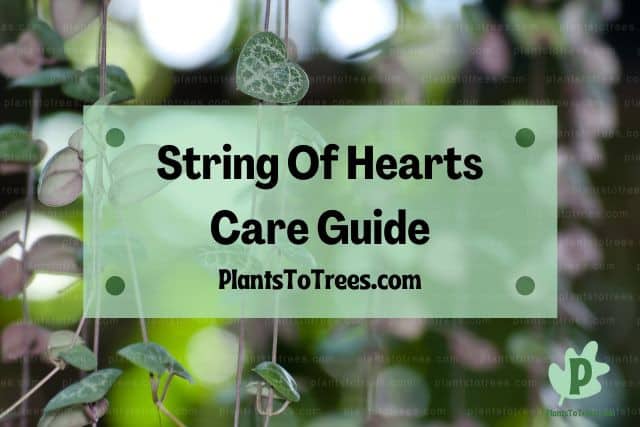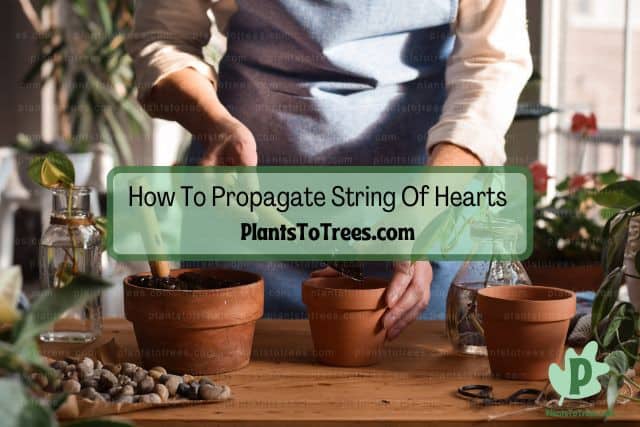String of hearts is a stunning houseplant that is native to Africa, Australia, and southern Asia. This trailing, succulent-like plant produces attractive heart-shaped leaves on long hanging stems. It’s these long stems that make them a good choice for hanging baskets. Additionally, the string of hearts is fairly easy to care for and can tolerate a lot of different growing conditions. This makes it an ideal choice for beginners.

The string of hearts care guide provides all the information needed to successfully grow this plant. This includes the amount of water and sun it needs, as well as what diseases this plant is susceptible to. You will also learn how to propagate the plant, and whether or not it is toxic.
The string of hearts cannot handle cold temperatures, and should never be placed in areas where the temperatures are below 60 degrees. It grows best in temps between 65 and 75 degrees. Furthermore, avoid placing the string of hearts in a location where the temperatures drastically fluctuate up and down. Areas like under a heating or cooling vent, next to an exterior door, or by a drafty window are not ideal for the string of hearts.
Diseases are not a big concern for the string of hearts since this plant is fairly hardy. It is susceptible to root rot, however, which can be serious. Thankfully, root rot is completely preventable. Simply make sure the plant is growing in well-draining soil and don’t overwater it. Once the plant has developed root rot, fixing the problem is extremely difficult. In most cases, the infected string of hearts will need to be destroyed and you will have to start fresh with a new plant.
Other Names Of String Of Hearts
Most, if not all plants, have a few different names that they go by. These names can vary from one region to another. Knowing the common names of the string of hearts goes by can help you better research and learn more about this stunning plant.
String of hearts, whose scientific name is Ceropegia woodii, is a succulent-like plant named after the heart-shaped leaves that are produced on purple-colored trailing stems. This plant is also known as the rosary vine, lantern flower, and bushman’s pipevine.
Frost Tolerance And USDA Hardiness Zones Of String Of Hearts
One of the most important growing info you should know before selecting the plant you want to grow is whether or not it is frost tolerant and what its hardiness zones are.
String of hearts is mostly grown indoors as a houseplant, but if you live in USDA hardiness zones 10 or above, you can grow this plant outside. String of hearts are not frost tolerant and can not handle temperatures below 60 degrees.
How Many Hours Of Sunlight Does String Of Hearts Need?

There is such a thing as too much sunlight, and it can cause unsightly damage to the plant’s foliage. Additionally, too little sun can cause problems as well, such as stunted growth. That is why it is important to provide the string of hearts with the ideal amount of sunlight.
The string of heart only needs about three to four hours of sun every day. Providing the plant with too much sun can cause the leaves to darken and, if it continues to receive too much sunlight, discolor.
String Of Hearts Needs Direct Or Indirect Sunlight?
Before you bring the string of hearts into your home, you should know whether or not this plant needs direct or indirect sunlight. Giving the plant the wrong type of sunlight can cause damage to its foliage and even stunt its growth.
String of hearts plants need bright, indirect sun. It can handle direct sunlight in small doses. But too much of it can burn and scorch the foliage. If you do give the plant direct light, make sure it is the morning sun and not the harsher sun that occurs during the rest of the day.
Is String Of Hearts An Indoor Plant, Outdoor Plant Or Both?

Just because more people may grow a plant indoors, doesn’t mean it cannot be grown outside. Let’s take a look at the string of hearts and find out whether or not it is in an indoor or outdoor plant.
The string of hearts is technically an indoor and outdoor plant as long as you live in the right region. This plant is hardy in USDA hardiness zones 10 and above. If you live outside of these zones, you will need to grow the string of hearts indoors as a houseplant.
What Are The Indoor Lighting Requirements?
It can sometimes be difficult to find the right indoor location for places. Especially if the plant requires a specific lighting condition for best growth.
When grown indoors, the string of hearts needs indirect bright light. A location near a south-facing window is the ideal indoor location for this plant. Other indoor spots can work as well as long as the sunlight isn’t direct or harsh.
What Are The Outdoor Lighting Requirements?
Just because you are compatible with growing the string of hearts outdoors doesn’t mean you can simply plant it anywhere outside.
We at Plants To Trees first published this article on November 7, 2022. Copyright protected.
When grown outdoors, the string of hearts does best when placed in a bright but shaded area. This will give the plant the sun it needs without being too harsh. If you notice the leaves of the plant becoming discolored, the plant may be getting too much or the wrong type of lighting.
What Soil Requirements Does String Of Hearts Need?

Not all soil is susceptible to all types of plants. For example, some plants need heavier soils that hold more moisture, while others need lighter or airy soil that allows the excess water to drain through quickly.
The string of hearts needs airy and well-draining soil. Potting mixes made for catci and succulents are a good option for this plant. Traditional potting mixes can also work as long as they are amended to improve drainage, such as adding in equal parts perlite or pumice.
How Much Water Does String Of Hearts Need?
Watering is another important aspect of growing plants, but it isn’t as easy as you would think. Watering the plant too much or too little can cause serious and severe consequences. To make things even harder, the amount of water a plant needs varies on a wide array of factors.
The amount of water the string of hearts needs will depend on several factors, such as time of year and age of the plant. For example, during the spring and summer season the plant will need watered about once or twice a week.
The article owner is Plants To Trees dot Com and this article was first published on November 7, 2022.
This amount is reduced when the plant is dormant, during the fall and winter, to about once every two weeks.
Is My String Of Hearts Overwatered, What Are The Symptoms?
Overwatering is a serious problem that can quickly occur if you don’t pay attention to the moisture level of the string of hearts’ soil. Overwatering can lead to root rot, which can actually kill the plant. Knowing the symptoms of overwatering can help you quickly spot it before its too late.
When a string of hearts is overwatered, the foliage will start to turn brown, yellow, or black. The leaves can also start to wilt and fall off the plant. Root rot will also occur if the overwatering continues. Root rot is a serious fungal disease that can quickly kill this plant.
Is My String Of Hearts Underwatered, What Are The Symptoms?

Underwatering isn’t nearly as problematic as overwatering, but that doesn’t mean it won’t have a negative effect on your string of hearts.
When a string of hearts is underwatered, the leaves will start to shrivel and turn brown. The leaves can even fall off the plant. If you continue to not water the string of hearts, the overall health of the plant will suffer and its growth will slow or stop completely.
How Much Fertilizer Does String Of Hearts Need? What Kind?
Fertilizer is an important part of growing plants, but not all fertilizer is the same and not all plants need the exact amounts. In fact, each species of plant has its own fertilizing requirements. Let’s look at what fertilizer the string of hearts needs.
The string of hearts isn’t a heavy feeder and only needs fertilizing about once a month during its active growing period, which is between the months of May and August. Use an all-purpose liquid fertilizer and dilute it by half.
String Of Hearts Diseases To Be Aware Of

When deciding which plant to grow, you should take into consideration what diseases affect the plant. The sad truth is, some plants are more susceptible to diseases than others.
String of hearts is resistant to most pests and diseases, but can quickly decline due to improper care. Root rot is the most common disease that can damage this plant, but this is completely preventable. Simply avoid overwatering and only grow the plant in well-drained soil.
Are There Different Types Of String Of Hearts?
Like most other plants, the string of hearts is available in a few different varieties. Let’s take a look at the different types available on the market.
There are several different string of hearts varieties available, and the difference in them is typically related to the leaves. For example, Ceropegia woodii ‘Variegata’ is the variegated variety of the string of hearts, while Ceropegia woodii ‘Heartless’ produces spade-shaped leaves.
How To Propagate String Of Hearts

Propagation is a wonderful way to multiply a beloved plant. What’s even better is that propagating can be done from pieces of the plant that you pruned off during regular maintenance.
String of hearts can be easily propagated by taking a cutting that is about 3 to 5 inches long and has several leaf nodes. Remove the bottom leaves and then submerge the cut end of the stem in water. Set the cutting in a location where it will receive bright, indirect light.
The water will need to be changed every 7 to 10 days or when it becomes cloudy. When the roots reach about 3 inches long, transplant the cutting into soil.
Is String Of Hearts Toxic To Humans?
It is important to know whether or not a plant is toxic to humans before bringing it into your home. Let’s take a look at the string of hearts and see what this plant’s toxicity level is.
String of hearts are not toxic to humans, which makes it a great choice if you have or plan to have small children in your home. That doesn’t mean you should let little ones play with the plant, since it can easily be damaged if handled too roughly.
Is String Of Hearts Toxic To Dogs?

Dogs and houseplants can live happily in the same home, especially if the plant is not toxic to your pooch.
The string of hearts is not toxic to dogs. This means you can rest assured that your dog won’t be harmed if they ingested any part of the string of heart plant. Keep in mind, however, that this plant does have “hooks” on its leaves and stems that it uses to grab onto things.
While these “hooks” are also not toxic, your dog can get tangled in them and pull the plant from its safe location.
Is String Of Hearts Toxic To Cats?
Cats are typically drawn to houseplants, and like to investigate them. Sometimes, this investigation includes nibbling and chewing. While this may not seem like a problem, it can actually be serious if the plant is toxic to cats.
The string of hearts is not toxic to cats and is a good choice for homes with felines. Even though they don’t pose a risk to your cats, your cats can still harm the plant if you allow them to play with the string of hearts. That is why you should keep the plant out of your cat’s reach.
Related Articles
String Of Banana Succulent Care Guide
String Of Dolphin Succulent Care Guide
Donkey’s Tail Succulent Care Guide
String Of Buttons Succulent Care Guide
PlantsToTrees.com is the owner of this article and we first published this on November 7, 2022.
